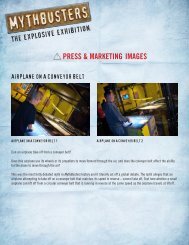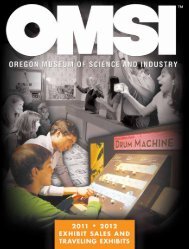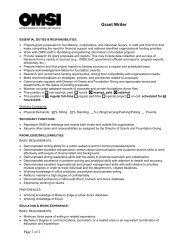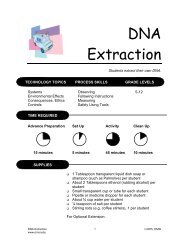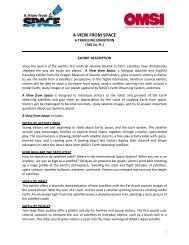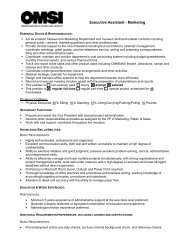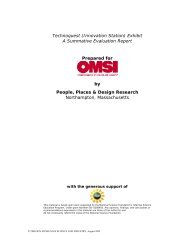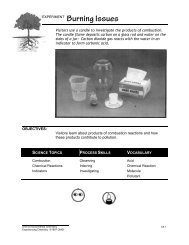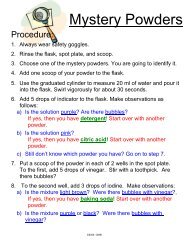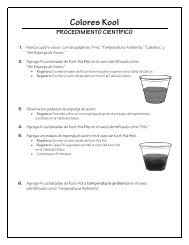Lesson 1: Taste and Smell - OMSI
Lesson 1: Taste and Smell - OMSI
Lesson 1: Taste and Smell - OMSI
- No tags were found...
You also want an ePaper? Increase the reach of your titles
YUMPU automatically turns print PDFs into web optimized ePapers that Google loves.
<strong>OMSI</strong>: OBPPage 1 of 7In this lesson, students work in small, collaborative groups to investigate the senses of taste <strong>and</strong>smell. Students are guided through the process of inquiry: asking "testable" questions, designingan investigation, collecting <strong>and</strong> organizing data, <strong>and</strong> analyzing <strong>and</strong> summarizing results.10 minutes for introducing the activity25 minutes for the activity10 minutes for discussion! Hypothesize about the relationship between the senses of taste <strong>and</strong> smell.! Carry out scientific inquiry <strong>and</strong> research to learn about the relationship between thesenses of taste <strong>and</strong> smell.! Summarize results in class discussion.! Discover that the senses of taste <strong>and</strong> smell are related.ObservingPredictingQuestioningHypothesizingInvestigatingComparing/ContrastingDesigning ExperimentsInterpreting DataWorking CooperativelyCommunicatingA dill pickle makes us pucker, but a taste of honey makes us smile. Why? When we eat differentfoods, chemicals in the foods are dissolved in saliva. These chemicals stimulate receptor cells inthe taste buds found on the tongue. Different receptor cells are sensitive to different chemicals.When a receptor cell responds to a chemical, it sends a signal along a nerve, first to the brainstem <strong>and</strong> from there to the temporal lobe of the cerebral cortex, where it is processed, <strong>and</strong> weidentify the taste.There are four basic tastes: sweet, sour, bitter, <strong>and</strong> salty. More complex flavors are made up ofcombinations of these four basic tastes. <strong>Taste</strong> buds clustered in different parts of the tongue aresensitive to different tastes.http://www.omsi.edu/explore/life/obp/u1_l1_body.html5/15/2001
<strong>OMSI</strong>: OBPPage 2 of 7Our sense of smell also depends on receptor cells that are sensitive to dissolved chemicals.These odor receptor cells (olfactory neurons) are found high up at the back of the nose, <strong>and</strong> theyare sensitive to chemicals dissolved in mucus. When you breathe in, you draw chemicals in theair up to these receptor cells. Signals are sent from these cells to nerve cells in the olfactory bulb,located just above the roof of the nasal cavity. From there messages go to the temporal lobe ofthe cerebral cortex, where they are processed.The senses of taste <strong>and</strong> smell work together. When we eat food, for instance, some moleculesare trapped in saliva <strong>and</strong> stimulate taste receptors, while other molecules travel up to the nasalpassages <strong>and</strong> stimulate odor receptors. The "flavor" of the food is really a combination of taste<strong>and</strong> smell. In fact, you've probably noticed that flavors are less intense when your sense of smellis blocked, for example, by the mucus produced by a bad cold.taste bud: a collection of taste receptor cells found primarily on the tongue.Introducing the Activity (per class)! blindfolds! bite-sized pieces of each of the following foods: potato, apple, orange, <strong>and</strong> lemon; orjellybeans of four different flavors! water <strong>and</strong> cups (for rinsing the mouth between foods)Activity (per group)! 4-6 small containers with lids (e.g., plastic yogurt cups)! 4-6 different types of soft drinks, such as cola, ginger ale, root beer, orange soda, grapesoda, <strong>and</strong> lemon-lime soda; or juices, such as grape juice, apple juice, orange juice,pineapple juice, berry drink, <strong>and</strong> lemonade! straws for sampling liquids! small paper cups (for individual students to use in sampling liquids)! blindfolds or strips of dark cloth (one per student)! nose clips (the type used by swimmers)! water <strong>and</strong> cups (for rinsing the mouth between drinks)! Gather <strong>and</strong> prepare the necessary materials for introducing the activity.! Gather <strong>and</strong> prepare the materials for each group to use during the activity. Put each drinkhttp://www.omsi.edu/explore/life/obp/u1_l1_body.html5/15/2001
<strong>OMSI</strong>: OBPPage 3 of 7in a different container <strong>and</strong> seal it. Label each container by number <strong>and</strong> keep a master listof container contents.! Make copies of Worksheets 1A <strong>and</strong> 1B (found at the end of the lesson).! Only the substances in the numbered containers should be tasted. In general, studentsshould not taste substances in the classroom unless specifically directed to by the teacher.Before beginning the taste tests, ask about any food allergies students may have.! Students should not share straws or utensils used for sampling liquids.! Spills should be cleaned up promptly. Make sure students know where to quickly findsponges <strong>and</strong> paper towels for cleaning up spills.! Some substances can be irritating if inhaled directly. Show students how to waft a scenttoward the nose instead.! Students should not share blindfolds.! Nose clips should be washed with soap <strong>and</strong> water before use by another student.1 Ask for two student volunteers for a taste test. Have one student wait outsidethe classroom, while the other student takes the taste test.2 Have the rest of the class observe the taste tests. Have one student recorddata on the board.3 Blindfold the first student. Let the student try bite-sized pieces of each of thefollowing foods <strong>and</strong> try to identify them: potato, apple, orange, <strong>and</strong> lemon.(You can use jellybeans of various flavors instead.) Have the student rinsehis or her mouth with water between foods.4 Test the second student.5 When the testing is finished, have students review the data. Which tasteswere easy to identify? Which were more difficult? Ask students how theywould explain the results. Ask students what senses they think the testerswere using <strong>and</strong> why they think so.Procedure1 Explain that students will have a chance to experiment <strong>and</strong> learn more aboutthe senses of taste <strong>and</strong> smell. Give students the following question to guidetheir inquiry: Is it easier to identify a taste using just your sense of taste orusing your senses of taste <strong>and</strong> smell together?2 Give students the materials available for experimentation.3 Guide students through the process of designing an investigation to answerthe question you posed. Ask students:http://www.omsi.edu/explore/life/obp/u1_l1_body.html5/15/2001
<strong>OMSI</strong>: OBPPage 4 of 7! How can you set up an experiment to compare the sense of tastealone with the senses of taste <strong>and</strong> smell together?! What variables do you need to control?! How do you make sure you're only testing the senses you want totest?! How can you "measure" your sense of taste?! What kind of data do you need to collect?! How will you organize your data?4 One way to set up the investigation is to do two rounds of testing: In the firstround, a student should wear a blindfold <strong>and</strong> nose clips, sample each drinkwith a straw, <strong>and</strong> try to identify the taste of each drink. (Students shouldrinse their mouths with water before sampling each drink.)In the second round, the student should remove the nose clips (but keep theblindfold on), sample the drinks again (in a different order), <strong>and</strong> try to identifythe taste of each drink. The two tests should be repeated with other studentsin the group. In the data table, students can record responses during eachround of testing.5 Have students work in groups of four. Each group member should have aspecific role. For example, one student could be in charge of organizingmaterials, one in charge of carrying out testing, one in charge of datacollection, <strong>and</strong> another responsible for sharing group results with the rest ofthe class.6 Give students Worksheet 1A on which to record their data. Give students 15minutes to experiment.7 Let students check their group members' responses against the master list ofcontainer contents to determine how many responses were correct. Givestudents a chance to summarize <strong>and</strong> analyze their data.8 Bring students back together to share the results of their experimentation.Let each group explain how they carried out their investigation <strong>and</strong> what theyobserved about the senses of taste <strong>and</strong> smell. Encourage students to offerexplanations for their observations <strong>and</strong> evidence to support theirconclusions. Ask questions like these: Why do you think that happened?How did you come to that conclusion?9 Give each student a copy of Worksheet 1B. Encourage students toexperiment further or do other research to answer the questions.! Have students map the different sensory areas of the tongue, using four solutions—coffee(bitter), sugar water (sweet), salt water (salty), <strong>and</strong> lemon juice (acidic). Students can workin pairs on this activity. One student should wear a blindfold <strong>and</strong> nose clips. Have the otherstudent use a cotton-tipped swab to apply each solution in turn to different parts of the firststudent's tongue <strong>and</strong> have the student tell where the sense of taste is strongest. Studentsshould use a different swab for each solution. Students should also rinse out their mouthswith water before testing each new solution. Students should record data on a diagram ofthe tongue. Have students share their results.! Combine two or three flavors in several solutions for students to sample. Have students tryhttp://www.omsi.edu/explore/life/obp/u1_l1_body.html5/15/2001
<strong>OMSI</strong>: OBPPage 5 of 7to identify the component flavors. Which flavor is the most easily identified in each mix?! Have students find out how many different smells they can identify. Choose substanceswith distinctive scents, such as coffee, cloves, orange peel, vanilla, banana, onion, garlic,peppermint, vinegar, blue cheese, dirt, pine needles, <strong>and</strong> cedar chips. Put each substancein a separate film canister with lid. Use a tack to make small holes in the lid. Label thecanisters by number <strong>and</strong> keep a master list of contents. Let students use the substancesto test their sense of smell. (You can also try combining scents <strong>and</strong> have students seewhether they can identify the component scents.)http://www.omsi.edu/explore/life/obp/u1_l1_body.html5/15/2001
<strong>OMSI</strong>: OBPPage 6 of 71ATASTE AND SMELLName/s ____________________________________Date _____________Data TablesUsing Sense of <strong>Taste</strong> OnlyStudent Drink 1 Drink 2 Drink 3 Drink 4 Drink 5 Drink 6Using Senses of <strong>Taste</strong> <strong>and</strong> <strong>Smell</strong> TogetherStudent Drink 1 Drink 2 Drink 3 Drink 4 Drink 5 Drink 61BTASTE AND SMELLName/s ____________________________________Date _____________Experiment or do research to answer the following questions.1. How does the tongue detect different tastes?2. Do all parts of the tongue respond to all tastes? Draw a picture of a tongue. Show which partsof the tongue respond to different tastes.http://www.omsi.edu/explore/life/obp/u1_l1_body.html5/15/2001
<strong>OMSI</strong>: OBPPage 7 of 73. Where is the sense of taste processed in the brain?4. How does the nose detect different smells?5. Where is the sense of smell processed in the brain?Home | About OBP | Inquiry | Print | FeedbackUnit 1 Overview | <strong>Lesson</strong> 1 | <strong>Lesson</strong> 2 | <strong>Lesson</strong> 3<strong>Lesson</strong> 4 | <strong>Lesson</strong> 5 | <strong>Lesson</strong> 6 | <strong>Lesson</strong> 7Oregon Museum of Science <strong>and</strong> Industry | http://www.omsi.edu/explore/life/obp/http://www.omsi.edu/explore/life/obp/u1_l1_body.html5/15/2001



